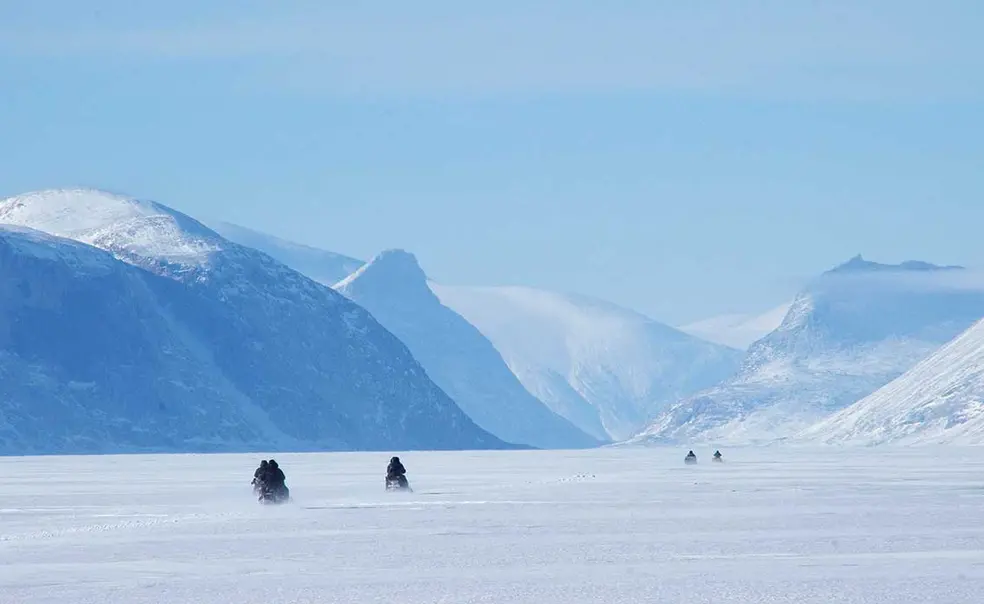What I Learned: Lessons From The Arctic

Henry P. Huntington ’87 lives in Eagle River, Alaska, where he works for Ocean Conservancy and as an independent Arctic researcher. Information from the weather stations is available at www.clyderiverweather.org. This project is supported by the U.S. National Science Foundation under Award No. OPP-1733580. Any opinions, findings, and conclusions or recommendations expressed in this material are those of the author and do not necessarily reflect the views of the National Science Foundation.
The wind presses against my facemask and finds holes around my sunglasses, the low windshield of my Ski-Doo providing little protection at 35 mph. I am following Esa Qillaq, D.J. Tigullaraq, and Colorado State University researcher Glen Liston through a maze of broken sea ice on the way to our weather station at Ailaktalik, in Nunavut, Canada, 25 miles from the Clyde River community. The skies are clear and calm — not quite as chilly as they were yesterday when we visited Silasiutitalik, another weather station, farther from town. We reach the shore and drive up the rocky hill to the station, aiming to find out why it quit transmitting a week ago.
Our work is part of a research project funded by the National Science Foundation. Clyde River — home to Esa, D.J., and about 1,000 others — is a hamlet that’s most of the way up the east side of Baffin Island and a couple of hundred miles north of the Arctic Circle. We want to understand how weather affects the Inuit, and thus what changing weather patterns may mean for them. The weather stations provide meteorological data that we can then try to connect with Inuit terminology and actions, to make sure we are all talking about the same thing.
Although the overwhelming majority of Nunavut’s 38,000 residents are Inuit and have been running their own 800,000-square-mile territory for 20 years, the legacy of colonial dependence remains powerful. For a long time, the Inuit have been on the receiving end of governance, research, social policies, and economic support. Although mining, fishing, and tourism produce some income, government services — largely supported by federal funds — remain the largest sector of Nunavut’s economy.
Here, global problems have local effects. Many industrial and agricultural pollutants accumulate in the Arctic, where the climate is warming at twice the global average, though the Inuit have done little to contribute to these problems. The sea ice over which we are driving is one of Earth’s most visible symptoms of climate change. By the end of summer, sea ice covers about 40 percent less of the Arctic Ocean than it did at the same time of year a few decades ago. In Clyde River, the ice forms later and melts earlier, throwing off seasonal rhythms for animals and people alike. One Clyde River resident, Joelie Sanguya, said he can still hunt seals, but it feels odd to be in his boat at a time of year when he thinks he should be on a Ski-Doo. Nowadays, the Inuit have to pay even closer attention when traveling on the ice because thin ice and cracks can be found in places where the ice used to be reliably thick and safe.
In this context, out on the wide-open tundra that is typical of Nunavut and the far north, a few remote weather stations hardly seem a vehicle for change. Yet they are part of a trend, a recognition of the capabilities of the Inuit and other minority and marginalized peoples at a time of growing demand by indigenous people to do their own work and make their own decisions. Which is exactly why Esa has led us out here this afternoon.
For a decade now, Esa has been a key part of our project, helping to choose the sites for our remote stations and carrying out routine and not-so-routine maintenance. Anemometers, which measure wind speed, wear out and need to be replaced; memory cards need to be retrieved from cameras; and every now and then Esa needs to fix what has been damaged by a curious or perhaps irritated polar bear.
When we began our work, we visiting scientists naively assumed that we might have something intelligent to contribute to Inuit decisions about going out hunting, fishing, and traveling on land and sea. By now we realize that, no matter how much experience we have traveling this and other northern landscapes, we remain comparative novices. The Inuit do not want our advice. Instead, they welcome the information that comes from the weather stations, provided via a website in English and Inuktitut, as they make their own decisions.
A few years ago, the Canadian government authorized a program of seismic testing in the waters of Baffin Bay, off the coast from the community. Seismic testing consists of making sudden, extremely loud noises in the water and recording the echoes that come from the seabed and the geological strata beneath. Clyde River residents worried that the noise would harm marine mammals and other wildlife that are a mainstay of life and culture here. They were unimpressed by the potential for oil or mineral wealth beneath the sea and had little confidence in the assurances of officials and consultants from southern Canada; they wanted to hear from their cousins in northern Alaska, whose waters have seen extensive seismic testing and other offshore activity. Clyde River eventually took its case to Canada’s Supreme Court, which found in the community’s favor, halting the program and marking a major victory for local voices.
The question of what matters to the Inuit in decision-making is another one where we have a lot to learn. We had started the project with the premise that poor weather would be a deterrent to travel because of discomfort. After all, who wants to go out when the wind chill is -70, -80, or -90 degrees? Traveling with our Inuit partners and listening to their stories, however, we realize that comfort is not the issue — safety is. Thus, in wintertime, the big hazards are flat light and whiteout conditions, in which it would be all too easy to drive your Ski-Doo off a cliff. In summer, wind and waves pose a risk to small open boats, by swamping if the waves are too big, or by blowing a boat out to sea if its motor dies in an offshore wind. Comfort can usually be achieved with the right clothing, though sometimes living in the Arctic just means dealing with what nature serves up, something we visitors try to accept with stoicism similar to that of our Inuit partners.
Our project is also part of a larger pattern here. To capitalize on local talent and to address local concerns, several years ago Clyde River founded its own research institute, named Ittaq, which is our local partner and home base while we are in the community. Ittaq’s offices are in a small building with stylish track lighting on a leaky ceiling, an apt symbol for progressive activities on a shoestring budget. Here, Inuit researchers are mapping the lands and waters on Inuit terms, through stories accumulated in a rich and deep oral tradition. Contemporary place names, sprinkled like confetti by early European visitors, are being restored to the Inuit originals, steeped in history and description and thus a vital aid to navigation across time and space.
For my part, driving a Ski-Doo and unscrewing a faulty anemometer seem a far cry from my undergraduate years as a rowing-obsessed English major. Writing my senior thesis, however, gave me a glimpse of the joys of independent research, leading to graduate school and then a career working with Arctic peoples and their environment. In three decades, I’ve seen a shift in the Arctic research community from “Why should we work with indigenous communities?” to “How do we work with them effectively and respectfully?”
Sitting in the sun with a cup of tea and snacks after diagnosing the problem with the weather station at Ailaktalik, Esa, D.J., Glen, and I chat about the project and about life in the North. The day before, on our way up the fjord, Esa found a seal den and in short order had fresh food to take home to share with his family and others. D.J. is disappointed not to find ptarmigan, which his pregnant partner seems to be craving. Tragedy is never far away, either, as we discuss the accidental death of a revered elder from Clyde River and a recent murder in a community up the coast.
Our time here reinforces the idea that learning how to work together with the Inuit, as with anyone else, is largely a matter of being there together. High-level policy interventions can help provide more opportunities for the Inuit to take control of their own affairs, as in a recent shift in Canadian government research funding that allows organizations like Ittaq to receive funds directly rather than through a university. Such steps are important, but do not provide academics or locals with an understanding of one another. In addition to our visits to Clyde River, Esa and other Inuit have come to Colorado to see the academics at home and work. They enjoyed speaking to a local high school class, were wary of riding horses, but enjoyed driving Glen’s tractor through a field. Perhaps going to a professional hockey game was the true highlight for the visitors from Canada.
As we get back on our Ski-Doo for the journey back to Clyde River, we are a team not because someone far away told us to become one, but because we spend time together, listen to one another, tease one another, and find shared purpose in what we do. Building relationships of this kind takes time, patience, and humility. There is no other way to connect across cultures, worldviews, and personalities. The wind again in my face, I think about how lucky I am to spend time beyond what is familiar and comfortable, to recognize the limitations of what I already know, and to see so much of our shared world.












1 Response
Peter S. Paine III ’85
6 Years AgoRowing With ‘Hammering Hank’
I read with great interest Henry Huntington ’87’s essay, “Lessons from the Arctic” (Princetonians, Dec. 4). In it, he briefly mentions that he was a “rowing-obsessed English major” during his undergraduate years. This hardly does justice to Henry’s rowing accomplishments and, modest as he is, Henry would never say more.
With no rowing experience prior to Princeton, Henry stroked four of the best lightweight collegiate crews ever to hit the water. In particular, as a sophomore, he stroked the legendary, undefeated 1985 lightweight varsity. That crew — immodestly named the “Best Evers” — is still the only lightweight crew to win a national heavyweight rowing title in the JV division (at the IRA’s in 1985). To those of us privileged to have rowed with Henry, he will always be known as “Hammering Hank” for the relentless power of his stroke and his unyielding tenacity. It is no surprise to his teammates that Hammering Hank thrives in the challenging Arctic environment.